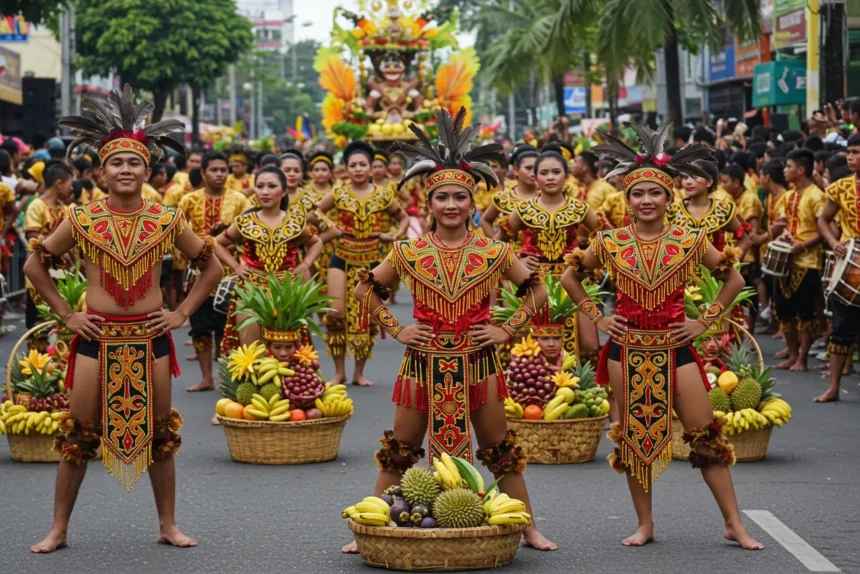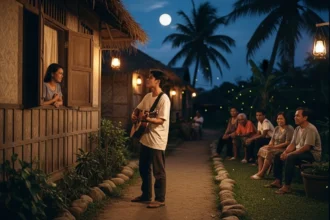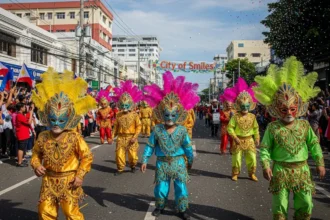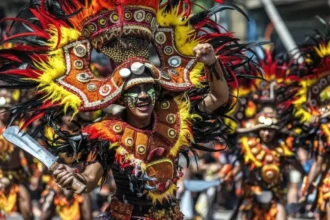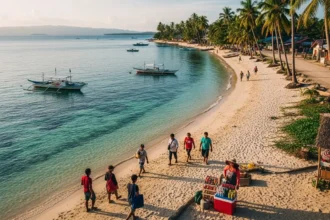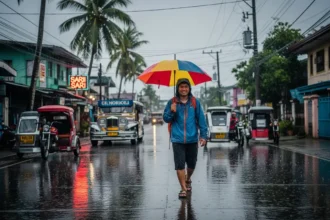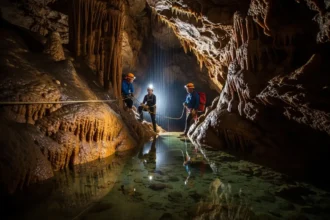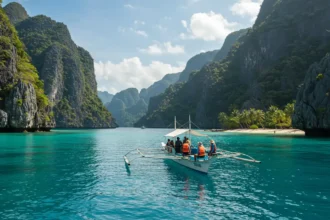Every August, Davao City bursts into a kaleidoscope of colors, smiles, and native rhythms as locals and tourists gather for the Kadayawan Festival – a month-long thanksgiving for nature’s blessings, rich harvests, and diverse cultures.
It’s not just a party; it’s a heartfelt tribute to Davao’s 11 indigenous tribes, the bounty of Mindanao, and the city’s deep respect for life and unity. From the street dances to the floral floats and tribal showcases, the Kadayawan Festival 2026 promises a one-of-a-kind cultural immersion that celebrates everything Davao stands for – peace, abundance, and pride. 🌸
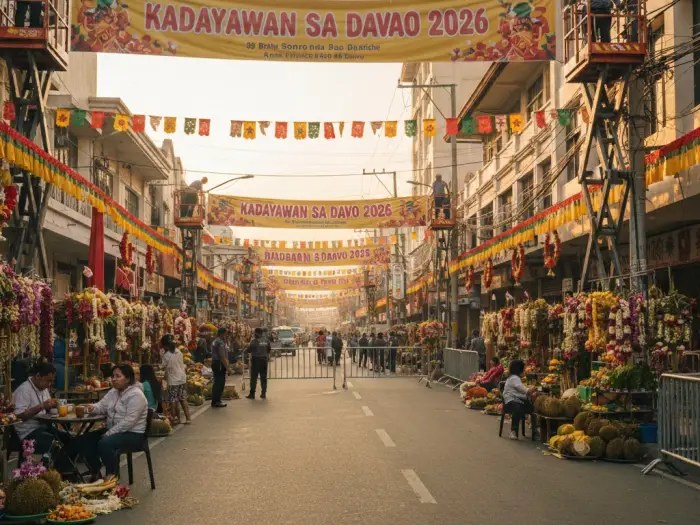
📅 2026 Schedule & Key Events
Every August, Davao City becomes the heart of Mindanao’s cultural pride through the Kadayawan Festival – a celebration of abundance, diversity, and unity. For locals, it’s more than a fiesta; it’s a pahalipay, a thanksgiving for good harvests, peaceful living, and the beauty of nature.
For 2026, the Kadayawan Festival is expected to run from August 1 to August 31, with the main events happening between August 14–16, according to previous years’ schedules released by the City Government of Davao and the Kadayawan Executive Committee. The final lineup is usually announced around June or July, but you can expect these core events to return – bigger, louder, and more colorful than ever.
| Date (Tentative) | Event / Activity | What to Expect |
|---|---|---|
| Aug 1, 2026 | Opening Ceremony at Magsaysay Park | The official start of Kadayawan with a ritual thanksgiving (panagtagbo) featuring music, traditional dances, and offerings to honor the 11 tribes. |
| Aug 3–9, 2026 | Hiyas sa Kadayawan Pageant 👑 | Davao’s cultural ambassador search, celebrating beauty, intellect, and heritage among women from the city’s tribes. |
| Aug 8–9, 2026 | Indak-Indak sa Kadalanan (Street Dancing) 💃 | The festival’s most anticipated parade – dancers in tribal-inspired costumes moving to the beat of gongs and drums along Roxas Avenue. |
| Aug 10–11, 2026 | Pamulak sa Kadayawan (Floral Float Parade) 🌸 | Giant floats made of fruits, flowers, and native materials showcase Davao’s bounty – a visual feast that fills the city with color. |
| Aug 12–18, 2026 | Tribal Village Exhibits (Madayaw Village) 🏕️ | A walk-through cultural showcase inside Magsaysay Park where you can meet and learn from Davao’s 11 indigenous tribes. |
| Aug 19–25, 2026 | Food, Art, and Music Festivals 🎶 | Street markets and concerts featuring local artists, Davao’s best dishes (hello, durian!), and Mindanao-made crafts. |
| Aug 31, 2026 | Closing Ceremonies & Fireworks Display 🎆 | The city wraps up Kadayawan with live performances, a drone show, and fireworks lighting up the Davao skyline. |
🌞 Local Timing Tip – Book and Bask Early
Davao’s hotels and flights get fully booked by late June, especially around the Indak-Indak weekend. Aim to arrive by August 13 if you want to catch the main street dances. The weather in August is warm and humid, but mornings are perfect for parades – bring a cap, shades, and water.
🚦 Crowd-Savvy Move – Stay Within City Core
Most festival events happen around Roxas Avenue, San Pedro Square, and Magsaysay Park. Choose a hotel near those areas so you can walk between activities – no need to deal with road closures or traffic detours.
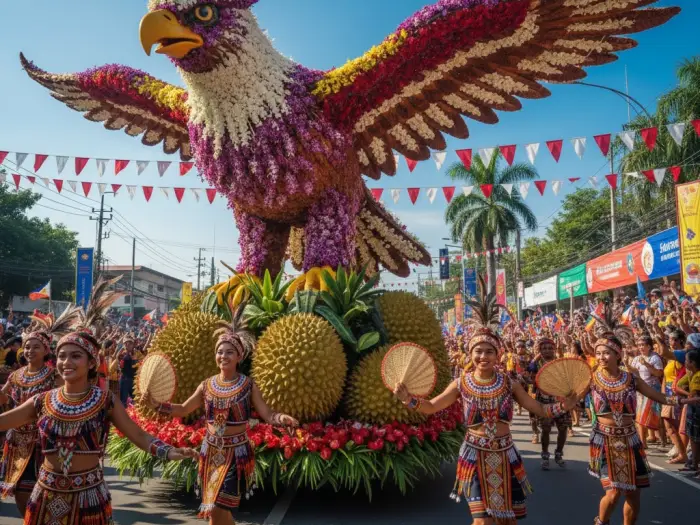
🎉 Parade Highlights & Cultural Attractions
The Kadayawan Festival 2026 isn’t just a citywide party – it’s a living, breathing story of Davao’s people. Every performance, every float, and every smile carries a piece of Mindanao’s soul. From the thunder of tribal drums to the scent of fresh flowers in the air, the city transforms into one big celebration of life, culture, and gratitude.
💃 Indak-Indak sa Kadalanan (Street Dancing Competition)
This is the heart of Kadayawan – a breathtaking parade where thousands of dancers, young and old, fill the streets in rhythmic unity. Indak-indak literally means “to dance in the streets,” and that’s exactly what happens: a joyful explosion of color, costume, and energy.
Each group tells a story – of harvest, peace, or ancestral traditions – through intricate choreography and beats that echo Davao’s tribal roots. You’ll see performers wearing feathered headdresses, beaded vests, and woven textiles from the Bagobo, Ata, and Matigsalug tribes, all moving to the sound of kulintang and agong.
Spectators line up as early as 5:30 AM along Roxas Avenue to claim good spots, and by sunrise, the entire area is vibrating with life.
Traveler’s Secret – Find the Pulse of the Parade
The best viewing areas are near San Pedro Cathedral and Roxas Avenue corner C.M. Recto – close enough for photos, but far enough to move easily between groups. Bring a hat, bottled water, and patience; it’s a long but magical morning.
🌺 Pamulak sa Kadayawan (Floral Float Parade)
If Indak-Indak is energy, Pamulak sa Kadayawan is elegance. Here, Davao’s creativity blooms – literally – as giant floats made of flowers, fruits, and native materials roll through the streets. Think Panagbenga, but with a Mindanaoan twist.
Each float represents a local company, school, or barangay, proudly showcasing their artistry through themes inspired by nature and heritage. Expect to see floats covered in orchids, anthuriums, heliconias, and durian motifs – all sourced from Davao’s rich soil.
The parade usually starts around 8:00 AM from Claveria Street and ends at San Pedro Square, followed by live cultural performances at the park.
Local Hack – Post-Parade Photo Ops
After the parade, selected floats are displayed near Rizal Park and People’s Park for public viewing. Visit in the afternoon for fewer crowds and golden-hour lighting – perfect for your travel photos.
🏕️ Madayaw Tribal Village
For something quieter but deeply meaningful, head to Magsaysay Park where the Madayaw Village showcases the living traditions of Davao’s 11 tribes – from the Bagobo-Tagabawa to the Obo-Manobo. Here, you can step into traditional huts, watch weaving demonstrations, or listen to storytellers share their ancestral myths.
It’s one of the most authentic ways to understand Kadayawan beyond the parades – a chance to meet the people who keep the culture alive.
Cultural Gem – Bring Small Tokens
When you visit the tribal booths, consider buying local crafts or offering small donations. These help fund community initiatives and keep indigenous art thriving. Plus, you get to take home a piece of real Mindanao craftsmanship – handwoven baskets, beadwork, or even musical instruments.
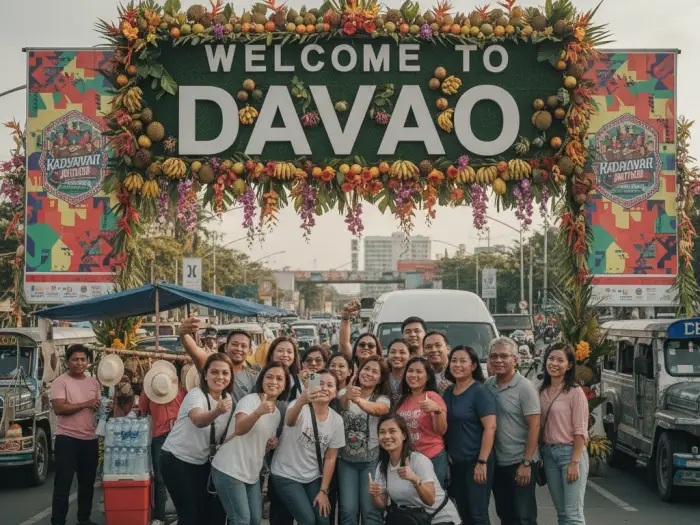
🧭 How to Get There & Travel Tips
Getting to Davao City for the Kadayawan Festival 2026 is a breeze – it’s one of the most connected and visitor-friendly cities in Mindanao. Whether you’re flying in from Manila, hopping a ferry from nearby islands, or road-tripping across the region, Davao’s hospitality and orderliness make it easy to explore.
✈️ Getting to Davao
| Route | Travel Time | Details & Tips |
|---|---|---|
| From Manila (Airplane) | 1 hr 45 mins | Direct flights daily via Cebu Pacific, PAL, and AirAsia. The Francisco Bangoy International Airport (DVO) is just 20 minutes from downtown. |
| From Cebu (Airplane or Ferry) | 1 hr flight / 10–12 hrs ferry | Flights are fastest, but ferries via Cokaliong or 2GO Travel offer a scenic, budget-friendly option. |
| From Cagayan de Oro (Bus/Van) | 6–7 hrs | Air-conditioned buses run regularly via the Davao–Bukidnon Highway. Great for those exploring Northern Mindanao. |
| From General Santos City | 3 hrs | A smooth land trip through the scenic Pan-Philippine Highway; perfect for South Cotabato travelers. |
Timing Trick – Arrive Midweek
If you’re targeting the main events (mid-August), fly in by Wednesday or Thursday before the Indak-Indak weekend. You’ll skip peak fares and still have time to explore Davao’s parks, cafés, and markets before the big crowds arrive.
🏨 Where to Stay During Kadayawan
Accommodations range from boutique hotels to homestays – but they fill up fast once July hits. Here’s a quick guide to help you choose the right area for your vibe:
| Area | Best For | Budget Range (per night) |
|---|---|---|
| Roxas Ave / Downtown Davao | Parade access, central location | ₱3,000–₱6,000 |
| Matina / Ecoland | Quieter stays, close to malls | ₱2,000–₱4,000 |
| Lanang / Bajada | Upscale hotels and sea views | ₱4,000–₱8,000 |
| Toril or Buhangin | Budget stays, local ambiance | ₱1,000–₱2,500 |
Local Hack – Stay Near the Action
If your goal is to catch every parade and concert, choose hotels near Roxas Avenue or San Pedro Square. Many visitors walk everywhere during Kadayawan, so proximity is gold. Just expect music and traffic until late – Dabawenyos celebrate with passion!
🕐 Best Time to Visit
The festival runs all month long, but the second and third weekends of August pack the biggest punch – that’s when the Indak-Indak, Pamulak, and concerts happen.
For a more relaxed trip, visit during the first week of August to enjoy pre-festival events, markets, and exhibits without the crowd crush.
🎒 What to Pack
Davao’s weather in August is generally warm (28–32°C) with a few short rain showers – perfect for outdoor fun, but you’ll want to stay comfy.
✅ Light cotton clothes or dri-fit shirts
✅ Hat or cap for parade watching
✅ Reusable water bottle
✅ Small umbrella or poncho for rain
✅ Power bank and phone charger
✅ Cash and valid ID (for checkpoints and payments)
✅ Foldable eco bag for pasalubong (fruits, crafts, coffee beans)
Traveler’s Secret – Pack Respect
Dabawenyos take pride in discipline and cleanliness. Jaywalking, smoking in public, and littering are strictly prohibited – and yes, they do enforce it. Smile, follow local rules, and the city will welcome you like family.
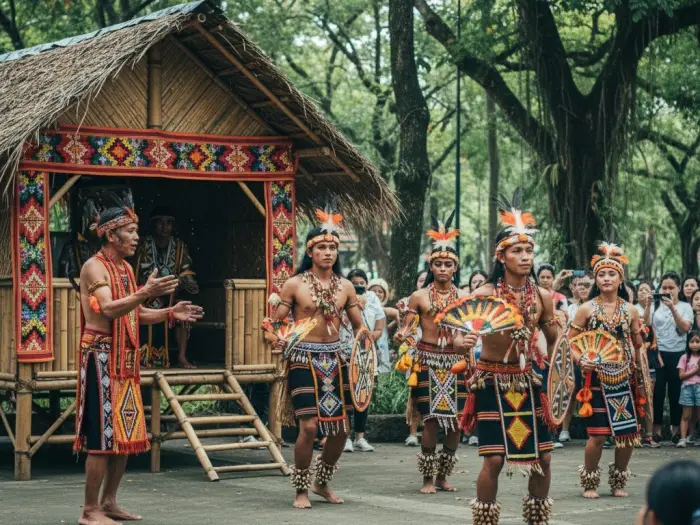
🌾 Kadayawan History & Cultural Significance
Before the concerts, floats, and selfies, Kadayawan Festival was first and foremost a prayer of gratitude – a thanksgiving from the tribes of Davao to the spirits of the land, the harvest, and life itself.
The name Kadayawan comes from the Mandaya word “madayaw,” meaning something good, valuable, or beautiful. It’s a fitting name for a celebration that honors everything Davao holds dear – its fertile lands, its peaceful people, and its deep cultural roots.
🌿 The Roots of Celebration
Long before Davao became a modern city, the 11 ethnolinguistic tribes – including the Ata, Matigsalug, Bagobo-Tagabawa, Obu-Manuvu, and Klata – would gather after harvest to offer thanks to their divine protectors, particularly Manama, the Supreme Being, and Bulul, the guardian of rice and grains.
They would dance, chant, and share food from the bounty of their harvest – corn, fruits, rice, and flowers – in harmony with nature. This ancient practice evolved into what we now know as the Kadayawan Festival, officially institutionalized in 1986 by then-Mayor Zafiro Respicio and promoted by Mayor Rodrigo Duterte in the years that followed.
From a small local thanksgiving, it blossomed into Mindanao’s biggest cultural festival, a proud symbol of peace and unity among Davao’s people.
Culture Note – The Spirit of Madayaw
Locals often say, “Kung unsay madayaw, ipasalamat.” (Whatever is good, give thanks for it.) That’s the essence of Kadayawan – it’s not just about prosperity, but appreciation. Gratitude for life, for land, and for coexistence.
🪶 A Celebration of the 11 Tribes
Unlike most festivals that focus on religion or tourism, Kadayawan shines a light on Davao’s indigenous tribes, known collectively as the 11 Tribes of Davao. Each tribe contributes its traditions, crafts, music, and dances – creating a festival that’s not only joyful but deeply rooted in cultural respect.
These tribes include:
- Ata
- Matigsalug
- Bagobo-Tagabawa
- Obu-Manuvu
- Klata-Guiangan
- Tausug
- Maguindanaon
- Maranao
- Sama
- Kagan
- Iranun
Their stories and rituals are showcased through the Madayaw Village exhibits, where visitors can experience their way of life up close – from traditional weaving and woodcarving to native cuisines and ceremonies.
Cultural Insight – Diversity in Unity
What makes Kadayawan unique is its message: peace through diversity. Davao celebrates not one identity, but eleven – each unique, yet harmoniously woven into the city’s identity.
🌸 From Harvest to Heritage
Today, the festival has grown beyond its agricultural roots. It’s now a showcase of everything that makes Davao exceptional – its floral beauty, abundant fruits, and rich mix of cultures. You’ll see durian-shaped floats, tribal dances side by side with hip-hop beats, and people from all walks of life celebrating as one.
Yet, through all the modernization, one thing hasn’t changed: Kadayawan remains a thanksgiving – not just for harvest, but for peace, progress, and the gift of community.
It’s a reminder that while cities evolve, traditions are what keep them alive. And in Davao, those traditions still bloom every August – colorful, proud, and truly madayaw. 🌾
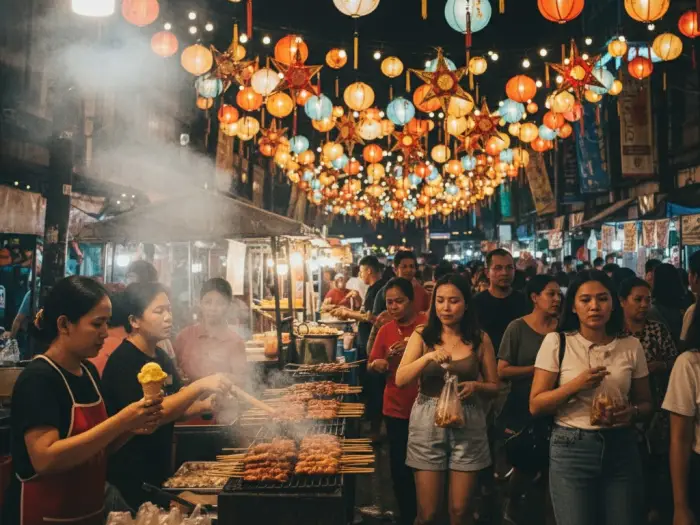
💡 Travel Hacks & Local Tips for First-Timers
If you’re heading to Davao City for the Kadayawan Festival 2026, expect more than just parades – it’s an experience that mixes culture, community, and celebration all in one. But Davao isn’t your typical fiesta city. It’s organized, disciplined, and proudly clean – which means you’ll have a great time as long as you know a few insider moves before diving into the crowd.
🕕 Arrive Before the Beat Drops
The city gets busier as Kadayawan weekend approaches, so plan to arrive two to three days before the main events (August 8–10). This gives you time to settle in, explore local cafés, and adjust to Davao’s laid-back rhythm.
Timing Trick – Beat the Festival Rush
Book flights by May or June, when fares are still reasonable. Avoid traveling on August 9 or 10 unless you love full airports and crowded terminals.
📸 Find the Best Photo Spots
Every corner of Davao turns festive in August, but these locations give you that perfect mix of energy and backdrop:
| Location | Why It’s Great |
|---|---|
| Roxas Avenue | Central parade route with colorful street decorations. |
| San Pedro Square | Close to both Indak-Indak and Pamulak parade routes. |
| People’s Park | Lush greenery and street performers – great for portraits. |
| Magsaysay Park (Madayaw Village) | Authentic tribal houses and cultural photo ops. |
Traveler’s Secret – Shoot Early Morning
The best light and least crowd happen between 6:00 AM to 8:30 AM. You’ll catch performers prepping and the streets freshly decorated.
🪙 Manage Your Budget Wisely
Davao isn’t as expensive as Manila or Cebu, and with a little planning, you can enjoy Kadayawan comfortably even on a tight budget.
| Expense | Estimated Cost (3D2N Trip) |
|---|---|
| Airfare (Round trip Manila–Davao) | ₱4,000–₱6,000 |
| Hotel (2 nights, midrange) | ₱3,000–₱5,000 |
| Food & drinks | ₱1,500–₱2,500 |
| Local transport & entrance fees | ₱800–₱1,200 |
| Souvenirs & extras | ₱500–₱1,000 |
| Total | ₱9,000–₱13,000 |
Budget Move – Eat Local, Eat Happy
Skip fancy restos and head for Roxas Night Market or Magsaysay Fruit Market. You’ll get grilled tuna belly, kinilaw, durian, and halo-halo for half the price – plus a front-row seat to Davao’s nightly buzz.
🚶 Navigate the Festival Like a Local
Davao may be the largest city in the Philippines by land area, but the festival core is compact. Most events happen within the city center, so walking or taking a tricycle or modern jeepney is your best bet.
Local Hack – Respect the Rules
Davao is famously strict – no smoking in public, no littering, no fireworks outside official events, and no late-night drinking in public spaces. Locals appreciate visitors who follow the rules – it’s part of what makes the city feel safe and orderly even during big crowds.
🎒 Pack Smart, Stay Light
You’ll be walking under the sun and possibly dancing in the rain, so pack for both.
✅ Light, breathable clothes
✅ Hat or umbrella
✅ Reusable water bottle
✅ Small towel or wet wipes
✅ Power bank
✅ Cash (some stalls don’t accept GCash)
✅ Eco bag for souvenirs and fruits
Traveler’s Kit – Kadayawan Edition
Locals swear by this setup: fan, bottled water, face towel, and a small pack of mints. Trust them – it keeps you fresh even after hours of parades and street food hopping.
🍽️ Eat, Drink & Be Madayaw
Davao’s food scene is diverse, just like its people. Between parades, take a food break and try these local stars:
- 🐓 Grilled Tuna Panga – smoky, juicy, and best with soy-calamansi dip.
- 🥭 Durian – Davao’s signature fruit, strong aroma but sweet reward.
- 🥥 Pomelo – fresh, tangy, and the perfect pasalubong.
- 🍛 Kinilaw – fresh tuna ceviche with vinegar and chili.
- 🍹 Civet Coffee or Davao Cacao Drink – smooth and proudly local.
Local Flavor – Eat Fearlessly
Dabawenyos love adventurous eaters. Try the durian candy or ice cream – locals will cheer you on (and maybe laugh at your first reaction).
🧠 Stay Safe & Culturally Aware
Kadayawan is a celebration of unity among Davao’s many tribes and faiths. Dress modestly when visiting the Madayaw Village or attending tribal events. Always ask before taking close-up photos of performers or locals – it’s seen as respect, not formality.
Davao is generally very safe, but as with any large crowd, keep your belongings close and avoid overly crowded zones late at night.
Mindanao Wisdom – Smile and Blend In
Dabawenyos are friendly but calm – no loud boasting or rowdy partying here. A simple “Madayaw, bai!” or “Salamat kaayo!” goes a long way in making local friends.
❓ FAQs About Kadayawan Festival 2026
1. When is the Kadayawan Festival 2026 in Davao?
The Kadayawan Festival 2026 is expected to run the whole month of August, with the main events – Indak-Indak sa Kadalanan and Pamulak sa Kadayawan – happening on August 8–10, 2026. The official schedule is usually announced around June or July.
2. What does the word “Kadayawan” mean?
Kadayawan comes from the Mandaya word “madayaw,” meaning something good, valuable, or beautiful. It reflects Davao’s gratitude for life, harvest, and peace among its people.
3. What is the origin of the Kadayawan Festival?
The festival traces back to ancient thanksgiving rituals by Davao’s indigenous tribes after harvest season. These gatherings evolved into a citywide celebration officially declared in 1986 to promote unity and cultural pride.
4. Where are the main Kadayawan events held?
Most events take place along Roxas Avenue, San Pedro Square, and Magsaysay Park, with parades ending near People’s Park. The Madayaw Village is also a must-visit cultural attraction inside Magsaysay Park.
5. How can I get to Davao for Kadayawan?
Fly directly to Davao International Airport (DVO) from Manila, Cebu, or other major cities. The airport is just 20–30 minutes from the city center. For nearby areas like General Santos or Cagayan de Oro, air-conditioned buses and vans are available daily.
6. What should I wear during the festival?
Wear light, breathable clothes and comfortable shoes. Bring a hat, small towel, and reusable water bottle. For tribal events, dress modestly out of respect for the cultural setting.
7. Is there an entrance fee to join Kadayawan Festival?
All major parades and street events are free and open to the public. Some concerts, food fairs, or VIP viewing spots may charge minimal fees depending on the organizer.
8. What are the top highlights of Kadayawan 2026?
Don’t miss the Indak-Indak sa Kadalanan (Street Dancing), Pamulak sa Kadayawan (Floral Parade), and the Madayaw Village. Each captures Davao’s soul through art, dance, and heritage.
9. What food is Davao known for during Kadayawan?
Kadayawan is the best time to try durian, grilled tuna panga, kinilaw, pomelo, and Davao cacao desserts. Visit Roxas Night Market for street eats and local drinks at budget-friendly prices.
10. Is Davao safe for tourists during the festival?
Yes – Davao is one of the safest cities in the Philippines. The city is known for strict local laws and visible police presence, making it very secure even for solo travelers. Just follow basic precautions and local regulations.
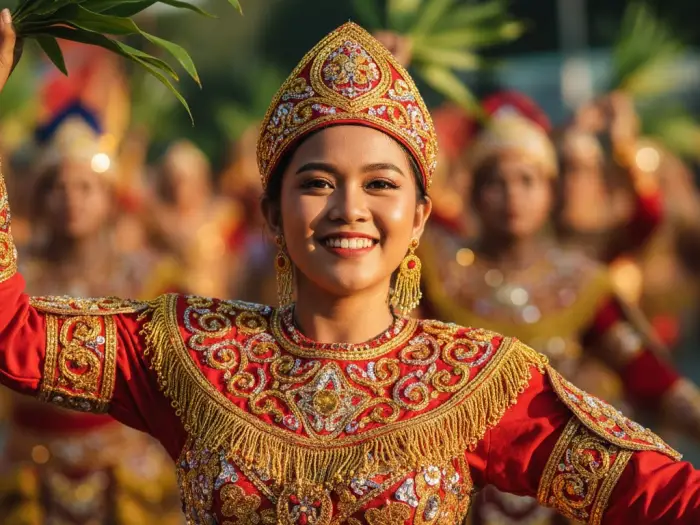
🌸 Celebrate Life, Culture, and Gratitude in Davao
The Kadayawan Festival 2026 isn’t just another city celebration – it’s a living tradition of gratitude, born from the heart of Mindanao. It’s where every dance, drumbeat, and smile tells a story of harmony between people and nature, and of a city that chooses peace over pride, gratitude over greed.
If you’ve never been to Davao in August, this is your sign. Plan early, pack light, and open yourself to the beauty of madayaw – goodness, joy, and connection. Watch the Indak-Indak dancers move with the earth’s rhythm, smell the durian and orchids that fill the air, and listen to the unity in every song.
Because when you experience Kadayawan, you don’t just see culture – you feel it. You feel what it means to be Filipino: thankful, joyful, and always ready to celebrate life. 🌾✨
🧭 References
- Wikipedia – Kadayawan Festival
- SunStar – Kadayawan Through the Years: Davao’s Cultural Celebration
- Mindanao Times – City Bares Calendar of Events for Kadayawan Festival 2025
- Agoda Travel Guides – Discover When Kadayawan Festival Shines in Davao City



